
MV Caledonian Isles, usually referred to locally as the Cally Isles, is one of the largest ships operated by Caledonian MacBrayne (CalMac), which runs ferries to the Hebridean and Clyde Islands of Scotland. Caledonian Isles serves the Isle of Arran on the Ardrossan to Brodick route. As it is one of CalMac's busiest routes, Caledonian Isles has the largest passenger capacity in the fleet, and can carry up to 1000 passengers and 110 cars, with a crossing time of 55 minutes. She is used extensively by day-trippers to the Isle of Arran during the summer.

MV Isle of Lewis is a ro-ro ferry operated by Caledonian MacBrayne between Oban and Castlebay, Barra. Built in 1995, she remains one of only two ships in the CalMac fleet over 100 metres (328 ft) in length; the other, Loch Seaforth, being longer by almost 15 metres.

The Caledonian MacBrayne fleet is the largest fleet of car and passenger ferries in the United Kingdom, with 34 ferries in operation, 2 on charter and another 6 on order. The company provides lifeline services to 23 islands off the west coast of Scotland, as well as operating routes in the Firth of Clyde.

MV Hebrides is a ferry operated by Caledonian MacBrayne from Uig to Lochmaddy and Tarbert, the main settlements of North Uist and Harris respectively.

MV Hebridean Isles is a ro-ro vehicle ferry operated by Caledonian MacBrayne on the west coast of Scotland. She was the first MacBrayne vessel to be ordered and built for them outside Scotland and the first to be launched sideways. With bow, stern and side ramps, Hebridean Isles is suitable for all the routes served by the large fleet units. After 15 years crossing the Little Minch on the Uig triangle, she now serves Islay and Colonsay.

MV Isle of Arran is a drive-through ferry operated on the west coast of Scotland by Caledonian MacBrayne. Entering service in 1984, she served on the Arran route for nine years before being moved to Kennacraig. She returned to her original route in 2012, supplementing MV Caledonian Isles in summer and becoming a relief vessel in winter. In 2013, she started a new pilot route from Ardrossan to Campbeltown, which became a permanent fixture in 2015. As of 2023, she is one of the oldest vessels in the fleet, having been in service for 39 years.
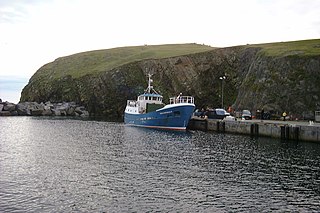
Good Shepherd IV is a Scottish ferry, connecting Fair Isle to Shetland Mainland. It is owned and operated by SIC Ferries.
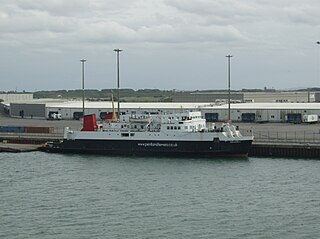
MV Pentalina-B was a ferry which operated on a variety of Scottish routes. Launched in 1970 as MV Iona, she was the first drive-through roll-on/roll-off ferry built for the David MacBrayne fleet. She was the first ship in the company's history to have bridge-controlled engines and geared transmission, rather than direct drive. During her career she inaugurated more endloading linkspans than the rest of the fleet put together. Purchased by Pentland Ferries in 1997, she was renamed MV Pentalina-B and operated across the Pentland Firth until the arrival of their new vessel. In 2009, she was sold to a Cape Verde owner.
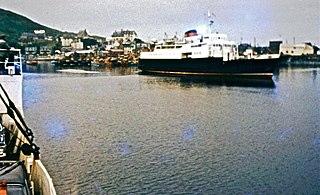
MV Clansman was the second of a trio of hoist-loading car ferries built for David MacBrayne Ltd in 1964 and operated on the Mallaig to Armadale, Skye route for ten years. Converted to ro-ro operation, she operated on the Stornoway, Isle of Mull and Arran services. Underpowered and troubled by mechanical breakdowns, she was taken out of service after 20 years.

MV Arran was a pioneering Firth of Clyde vehicle ferry introduced by Caledonian Steam Packet Company in 1953. She spent fifteen years on the Upper Clyde crossings, followed by five years at Islay. Initially hoist-loading, via side ramps, these were replaced by a stern ramp in 1973. During her final years with CalMac, she relieved across the network. Several unsuccessful attempts were made to turn her into a floating restaurant, before she was scrapped in 1993.
MV Bute was a Clyde vehicle ferry introduced by Caledonian Steam Packet Company in 1954. She spent 24 years on the Upper Clyde crossings. During her final years with Calmac, she relieved in the west highlands.
Shetland Islands Council Ferries is a company operating inter-island ferry services in Shetland, a subarctic archipelago off the northeast coast of Scotland. The company operates services across 10 of the Shetland islands.
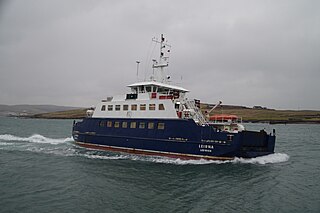
MV Leirna is a double ended ro-ro passenger ferry operated by SIC Ferries. She operates between Bressay and Lerwick.

MV Daggri is a double ended ro-ro passenger and car ferry that operates on the Yell Sound service by SIC Ferries. She is the sister ship of MV Dagalien.
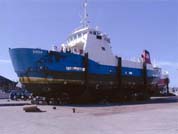
MV Bigga is a ro-ro passenger ferry operated by the SIC Ferries. She operates as the shift vessel on the Bluemull Sound service.

MV Geira is a ro-ro passenger and car ferry that operates on the Bluemull sound service, operated by SIC Ferries. She is based in Hamars Ness, on Fetlar.

MV Hendra is a ro-ro passenger ferry operated by the SIC Ferries. She operates as the day vessel on the Laxo or Vidlin to Symbister, Whalsay service.

MV Fivla is a ro-ro passenger ferry operated by the SIC Ferries. She operates as the fleet relief vessel.

MV Snolda is a ro-ro passenger ferry operated by the SIC Ferries. She operates as the West Burrafirth to Papa Stour service. The ship was originally named MV Filla until 2003.
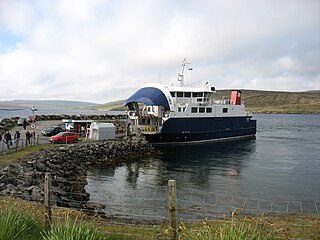
MV Linga is a ro-ro passenger ferry operated by the SIC Ferries. She operates as the shift vessel on the Laxo or Vidlin to Symbister, Whalsay service.



















